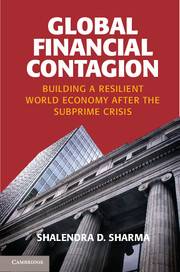Book contents
- Frontmatter
- Contents
- List of Figures
- List of Tables
- Acknowledgments
- Introduction
- One The United States
- Two The Bush and Obama Administrations’ Response
- Three From the U.S. to the European Crisis
- Four The Eurozone’s Sovereign-Debt Crisis
- Five Russia
- Six China
- Seven Japan, South Korea, and India
- Eight The Middle East amid the Global Financial Crisis
- Nine The Great Recession and the World’s Poorest
- Ten G-20 World
- Bibliography
- Index
One - The United States
Why the Trigger?
Published online by Cambridge University Press: 05 June 2014
- Frontmatter
- Contents
- List of Figures
- List of Tables
- Acknowledgments
- Introduction
- One The United States
- Two The Bush and Obama Administrations’ Response
- Three From the U.S. to the European Crisis
- Four The Eurozone’s Sovereign-Debt Crisis
- Five Russia
- Six China
- Seven Japan, South Korea, and India
- Eight The Middle East amid the Global Financial Crisis
- Nine The Great Recession and the World’s Poorest
- Ten G-20 World
- Bibliography
- Index
Summary
In their authoritative study, This Time Is Different: Eight Centuries of Financial Folly, Reinhart and Rogoff (2009) points out that the past can be the prologue as they show that financial panics and crises are not episodic, but have occurred with remarkable frequency throughout recorded history. In the United States, major crises occurred with debilitating frequency: in 1792, 1797, 1819, 1837, 1857, 1873, 1893, 1907, and 1929–33. Then, for the next several decades, although there were bumps, there were no major financial crises. Since the 1980s the “Great Moderation” further underscored the notion that macroeconomic volatility was a thing of the past. As Figure 1.1 illustrates, beginning in the mid-1980s, the volatility of the U.S. economy was markedly lower than it was in the earlier part of the postwar period, and certainly much less than during the interwar period.
Overall, during the period from 1980 to mid-2000 growth rate volatility underwent a dramatic moderation from the 1950s to the 1970s. The largest recession of the postWorld War II era was in 1982 when real per capita GDP fell by 3 percent and the unemployment rate peaked at nearly 11 percent. After 1984, the growth rates were only about half as volatile than they were during the earlier postwar period. By 2000, the U.S. fiscal situation looked robust. The federal budget recorded a surplus of 2.4 percent of GDP, and the Congressional Budget Office (CBO 2001) boldly projected a surplus of some $5.6 trillion by 2011. In fact, even as late as September 2008 – in the midst of a gigantic financial meltdown – the CBO (2008) was confidently predicting only a “mild recession” with GDP growing by only 0.9 percent in 2008 but rebounding back to 1.8 percent in 2009.
- Type
- Chapter
- Information
- Global Financial ContagionBuilding a Resilient World Economy after the Subprime Crisis, pp. 32 - 62Publisher: Cambridge University PressPrint publication year: 2013



